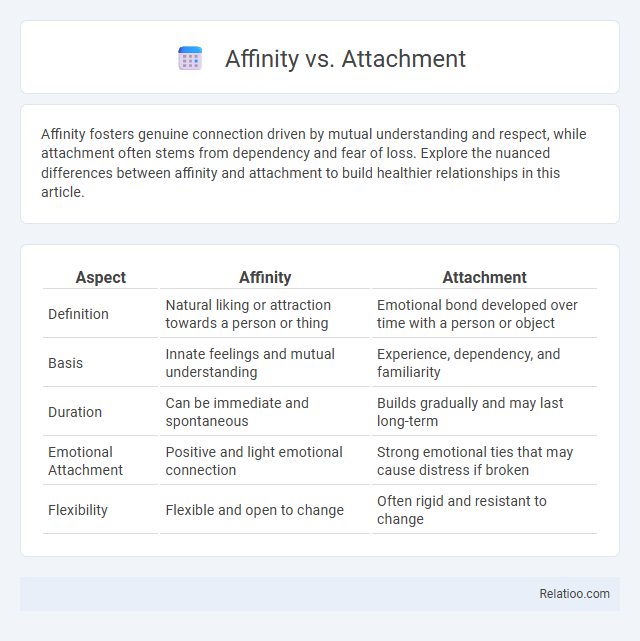Affinity fosters genuine connection driven by mutual understanding and respect, while attachment often stems from dependency and fear of loss. Explore the nuanced differences between affinity and attachment to build healthier relationships in this article.
Table of Comparison
| Aspect | Affinity | Attachment |
|---|---|---|
| Definition | Natural liking or attraction towards a person or thing | Emotional bond developed over time with a person or object |
| Basis | Innate feelings and mutual understanding | Experience, dependency, and familiarity |
| Duration | Can be immediate and spontaneous | Builds gradually and may last long-term |
| Emotional Attachment | Positive and light emotional connection | Strong emotional ties that may cause distress if broken |
| Flexibility | Flexible and open to change | Often rigid and resistant to change |
Understanding Affinity and Attachment
Affinity describes a natural liking or connection between entities, often based on shared qualities or interests, while attachment refers to a deeper emotional bond formed through repeated interactions and dependency. Understanding affinity involves recognizing innate or spontaneous connections, whereas attachment emphasizes emotional investment and commitment over time. Differentiating these concepts aids in analyzing relationships in psychology, marketing, and social dynamics, highlighting how initial attraction can evolve into strong personal or brand loyalty.
Definitions: Affinity vs Attachment
Affinity refers to a natural liking or attraction toward someone or something, often based on shared qualities or interests that create a sense of connection. Attachment describes an emotional bond formed through personal experiences, leading to dependency and a desire for closeness or security. Understanding the distinction between affinity and attachment helps clarify whether feelings arise from inherent compatibility or developed emotional bonds.
Psychological Perspectives on Affinity
From a psychological perspective, affinity represents a natural, often subconscious, emotional connection or preference toward people, ideas, or objects, which fosters positive feelings and social bonding. Attachment, distinct from affinity, involves a deeper, more enduring emotional bond typically formed through consistent caregiving, critical for emotional security and development. Understanding the nuances between your affinity and attachment can enhance self-awareness and improve relationships by recognizing which connections are rooted in instinctive liking versus deeper emotional dependence.
The Nature of Emotional Attachment
Emotional attachment reflects a deep, enduring bond formed through consistent interaction, often characterized by feelings of security and comfort. Affinity denotes a natural liking or attraction toward a person or object, typically without the intense emotional dependence seen in attachment. Unlike affinity, attachment involves a psychological need and reliance, often tied to emotional regulation and interpersonal connection within relationships.
Key Differences Between Affinity and Attachment
Affinity refers to a natural liking or attraction toward someone or something, often based on shared qualities or interests, while attachment denotes a deeper emotional bond formed through experience or dependency. You can distinguish affinity as an initial, often spontaneous connection, whereas attachment develops over time through interactions and emotional investment. Understanding these key differences helps clarify how relationships evolve from simple affinity to strong attachment.
How Affinity Develops in Relationships
Affinity develops in relationships through shared experiences, emotional resonance, and mutual understanding that create a natural sense of connection and comfort. Unlike attachment, which often stems from a need for security or dependency, affinity grows from genuine appreciation and alignment of values, interests, or personalities. Your ability to nurture affinity relies on open communication, empathy, and consistent positive interactions that foster trust and a deeper bond.
The Formation of Attachment Bonds
The formation of attachment bonds is a critical psychological process where individuals develop strong emotional connections based on trust and security, distinct from the general liking represented by affinity or the habitual dependency found in attachment. Attachment develops through consistent responsiveness and caregiving, often observed in early childhood between infants and caregivers, fostering feelings of safety and emotional regulation. Affinity centers on shared interests or similarities, lacking the deep emotional commitment that characterizes attachment bonds crucial for social and emotional development.
Effects of Affinity and Attachment on Behavior
Affinity fosters positive social interactions by promoting feelings of closeness and trust, enhancing cooperation and empathy in relationships. Attachment influences behavior through emotional bonds, where secure attachment leads to healthier interpersonal dynamics, while insecure attachment can result in anxiety or avoidance patterns. Both affinity and attachment shape motivation and social decision-making, impacting how individuals respond emotionally and interact within communities.
Breaking or Changing Affinity and Attachment
Breaking or changing affinity and attachment involves reshaping your emotional bonds and preferences through conscious effort and self-awareness. While affinity reflects a natural liking or connection, attachment denotes a deeper emotional dependency that may require intentional strategies to alter, such as cognitive reframing or behavioral adjustments. Understanding these distinctions helps you navigate and transform your relationships and preferences effectively.
Choosing Between Affinity and Attachment in Personal Growth
Choosing between affinity and attachment in personal growth requires recognizing that affinity reflects a natural connection and mutual understanding, fostering genuine relationships that support your development. Attachment often involves emotional dependence, which can hinder independence and lead to unhealthy patterns if not managed carefully. Prioritizing affinity encourages balanced growth through meaningful bonds while maintaining your autonomy and emotional well-being.

Infographic: Affinity vs Attachment
 relatioo.com
relatioo.com